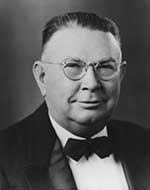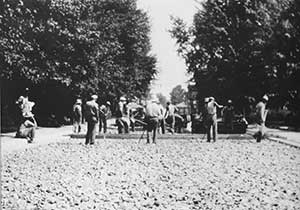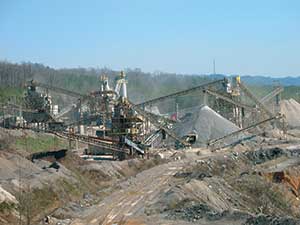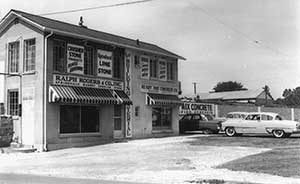Pit & Quarry Hall of Fame Profile: Ralph Rogers
Pioneer seized great opportunities, helped grow the nation.
Ralph Rogers laid the groundwork for what is now the largest privately owned aggregate company in the United States. The company that started in 1908 with a single roadside operation in Bloomington, Ind., now operates quarries, asphalt plants and construction units in six states across the Midwest and Southeast.
According to grandson Rick Rechter, a past Rogers Group chairman of the board, his grandfather started his life with little to his name. Rogers was not educated beyond the eighth grade, and it’s a mystery to the family how Rogers was able to finance the rapid growth of the company during World War II years.
Regardless of how Rogers financed his company early on, he had the foresight to make investments at a time of great opportunity.
“When the war began Mr. Rogers had anticipated it and had purchased and put in storage a vast amount of construction and crushing equipment,” Rechter says. “He stored it in an underground mine in Louisville, Ky. When the war broke out and things started getting hectic, his companies built a lot of the bases that trained our soldiers.”
The most famous Rogers Group project from that era was related to the Manhattan Project and the race to build a nuclear bomb. The U.S. settled on a valley in Tennessee to do this research and development. The city of Oak Ridge, Tenn., emerged from that valley, and it immediately became one of the largest cities in the state because the production staff there needed housing.
Of course, behind Oak Ridge’s rise and the Clinton Engineer Works facility was Rogers.
“The reason he was a supplier was that he promised once he got a contract to be producing stone in 30 days,” Rechter says. “You can’t get a permit from the EPA (Environmental Protection Agency) in 30 days today, let alone local board approval. But he understood that the people who were going to have the opportunity to produce materials for the country had to have the equipment to do it.”
Adds Ben Rechter, Ralph’s great-grandson and current chairman at Rogers Group: “He was very tenacious like a pitbull. Some people said that couldn’t be done. He asked what resources were needed to get it done. Usually, his people put their mind to it and got a job done.”
Unique legacy
In addition to Oak Ridge, Rogers Group was the primary aggregate provider for several other military installations. Among them were Camp Forrest in Tennessee; Fort Campbell in Kentucky; the U.S. Naval Ammunitions Depot in Indiana; and Redstone Arsenal in Alabama.
“If you look at the history of war and all of the major Army bases in the Midwest, Ralph had an aggregate operation there,” Rick says.
In later years, Rogers and his partners were among the first major road builders involved in President Dwight Eisenhower’s Interstate Highway System. Rogers Group supplied stone for major interstate sections in Alabama, Indiana, Kentucky, Ohio and Tennessee, and it built some of those sections as well.
“He had the spirit of a true entrepreneur because he expanded the company into various geographic markets based on his concept of where opportunities would be,” says Jerry Geraghty, president and CEO at Rogers Group.
Rogers was a bit unique in that he largely chose not to operate in big cities. Despite having roots in Indiana, Rogers never had an operation in Indianapolis. He avoided Illinois, as well, because the politicians there concerned him.
“He chose states and communities within those states where politicians did not have their hands in [businesses],” Rick says.
According to Rick, Ralph was effective at managing operations in multiple states because he was highly mobile.
“Many times when I was a kid he would fly down to Nashville or Tennessee on a Sunday afternoon,” Rick says. “He wanted to go alone. He’d spend two or three hours talking with the management, much to their chagrin, and then he would fly home.”
Man of the people
Perhaps Rogers’ greatest asset was his people. He was a good judge of men, Rick says, and he surrounded himself in post-war years with middle managers who were war veterans.
“His ability to pick that group after the war propelled us and left me with a really good bunch of engineers, construction people and miners,” Rick says.
Rogers also created a corporate culture in which the “man in the pit” was just as important as the company’s executives and elected officials.
“Ralph really appreciated the people because he was one of them,” Ben says. “He started out digging ditches and those sorts of things. He wasn’t highly educated, so he really appreciated the workers.”
According to Ben, Ralph paid his workers well and offered health and welfare insurance to employees ahead of the industry.
“I think by doing that he got a lot of loyalty,” Ben says. “That helped when he decided to branch off 200 miles into another state. His workers were willing to go and open up those operations.”
Ralph also put his workers’ safety first, and that probably endeared many workers to him.
“He made safety a priority before it was required,” Geraghty says. “He put the mantra out there that safety was important. In our core purpose, we have something called the Rogers Way. Together, we create opportunities for people to succeed. I believe [Rogers] is the individual who created that philosophy and culture in the company.”
Rogers actually began working around 1905 on a construction crew in southern Indiana. He learned the road-building industry through his work as a driver for a crew supervisor, and in 1908 he and his business partners launched Bloomington Crushed Stone in Indiana. The stage was set for Rogers Group, and within 20 years Rogers had expanded the business to three other states.
Key to the company’s rise was Ralph’s belief in maintaining partnerships and sharing risk with others, Geraghty adds.
“Ralph envisioned opportunities and acted on them,” Geraghty says. “Many times he would take a partner and mass enough investment power to go into a new market. He was very open to new structures, whether it was a joint venture or partnerships to enter new markets.”
Video Bonus: Check out a video of Ralph Roger’s achievements.
Photos: Ralph Roger














